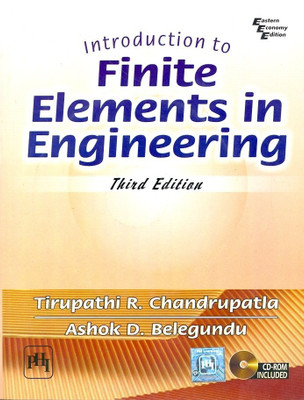Introduction to Finite Elements in Engineering(English, Paperback, Chandrupatla Tirupathi R)
Quick Overview
Product Price Comparison
With a careful integration of comprehensive theory with practical examples and exercises, Introduction To Finite Elements In Engineering provides all the required coverage on the topic for students and practitioners alike. Summary Of The Book The third edition of Introduction To Finite Elements In Engineering retains the philosophy and strategy of the earlier editions, and has also been updated to add new information on existing and new topics. The book gives a detailed look at the methodologies of finite elements. The theory has been dealt with in a comprehensive manner, revealing the various aspects of analysis and development of finite element theory. This detailed theory is combined with numerous examples and exercises. The practical engineering situations, provided as examples, make it easy for the students to understand the concepts and deal with real-life problems. Around 250 illustrations have been given throughout the text. The authors have also implemented the steps used in the development of various theories. The third edition contains new topics like acoustics, eigenvalue evaluation, axisymmetric quadrilateral elements, and conjugate gradient approach. It also includes the concepts of pre and post processing as the last chapter. The book is also accompanied by a CD that contains complete computer programs in MATLAB, QUICKBASIC, C, FORTRAN, Visual Basic, and Excel based Visual Basic. There are 12 chapters in the book. The topics covered in these chapters are Fundamental Concepts, Gaussian Elimination and Matrix Algebra. These are followed by chapters on Trusses, One-dimensional Problems, 2-dimensional Problems Using Constant Strain Triangles, Numerical Integration and 2-dimensional Isoparametric Elements, Beams and Frames, Scalar Field Problems, 3-dimensional Problems problems in Stress Analysis, Dynamic Considerations, Pre and Postprocessing. The emphasis on modeling and problem formulation in each chapter enables the students to develop a comprehensive understanding of these essential skills. The theory, combined with examples, makes the book extremely useful for undergraduate and postgraduate students. About The Authors Tirupathi R. Chandrupatla is a professor and Chair at Rowan UniversityŌĆÖs Department of Mechanical Engineering. He has written other books like Quality and Reliability in Engineering and Dimensional and Cost Considerations for Superabrasive Grinding.┬ĀChandrupatla did his BS from Warangal, and his MS from IIT-Bombay. He completed his PhD from the University of Texas at Austin. He began his career with Hindustan Machine Tools, Bangalore, as a design engineer. His teaching career began at LLT, Mumbai. A member of ASME, NSPE, SAE, ASEE, and SME, he is a registered professional engineer, as well as a certified manufacturing engineer. Prior to this, he taught at the University of Kentucky, and at the GMI Engineering and Management Institute for 16 years. Ashok D. Belegundu is a professor of Mechanical Engineering, Pennsylvania State University. Other books by him are Optimization Concepts and Applications in Engineering.┬ĀBelegundu did his MS from IIT-Madras, and his PhD from the University of Iowa. In 1993, he was awarded a fellowship by NASAŌĆÖs Lewis Research Center. He has done several projects for the industry and the government. Belegundu is an Associate Fellow of AIAA, and an ASME member.


